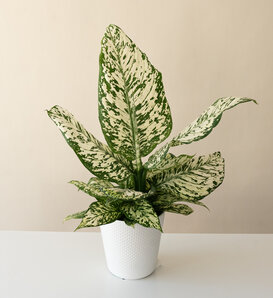Catamount™ Tasmanian Tiger™ Dumb Cane Dieffenbachia hybrid
Select any icon above to view the complete collection.
Learn more about Proven Winners® leafjoy® houseplants
- Medium
- High
-
24 - 48 Inches0 -0 -61cm - 1.2m0cm0cm
Features
Catamount™ Tasmanian Tiger™ boasts large, dark green leaves with mottled yellow striping that mimics the majestic stripes of a tiger. Growing quite large over time, Tasmanian Tiger™ has the potential to reign supreme over your collection, especially if it is given medium to bright light, consistent moisture, and warm temperatures above 60 degrees. This is an easy-to-grow variety, overall, but it does not like cold drafts. The common name for this plant is “dumb cane” because consumption of its sap may cause throat swelling & speechlessness, thus rendering one “dumb.”
Adaptable As HouseplantFoliage InterestHarmful To:PetsCharacteristics
Plant Type:HouseplantHeight Category:TallHeight:24 - 48 Inches 61cm - 1.2mFlower Colors:GreenFoliage Colors:GreenFoliage Shade:Emerald GreenHabit:UprightContainer Role:ThrillerPlant Needs
Light Requirement:HighLight Requirement:MediumLow - No direct sun, not near a window. Medium - Medium bright indirect light in the AM or PM, typically from an east or west window. High - Bright direct or indirect light for much of the day, typically from a south window.
Maintenance Category:ModeratePreferred Temperature:60 - 85 °FWater Category:AverageHumidity Preference:HighContainer Soil Type:Indoor Potting MixNeeds Good DrainageUses:Bright SpacesUses:Humid SpacesUses:Low Light SpacesUses Notes:Not for human or animal consumption.
Maintenance Notes:- For optimal performance, keep your Dieffenbachia at 60-85°F (15-29°C).
- Dieffenbachias are adaptable, easy-to-grow plants, capable of thriving in varying levels of light & humidity. They will grow most vigorously in medium to bright, indirect light, with medium to high humidity. They can generally adapt, however, to lower lighting and ambient household humidity. Exposure to direct sunlight, especially in the middle of the day, can lead to leaf scorch. Exposure to not enough light, may lead to reduced variegation and smaller leaves.
- Dieffenbachias prefer to dry out in between waterings. As such, water your Dieffenbachia thoroughly when the top two inches of soil feel dry.
- Feed your Dieffenbachia once per month at half strength when it is actively growing. Reduce frequency of fertilization in the winter months.
- Protect furniture when watering & fertilizing.
- Dieffenbachias have the potential to grow quite large over time. When repotting your Dieffenbachia, use an all-purpose potting mix, with perlite added to ensure good drainage.
-







